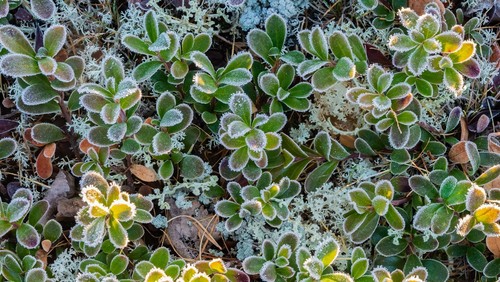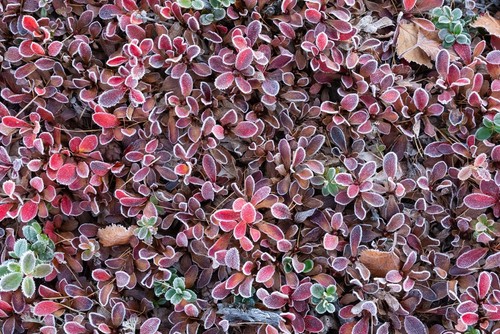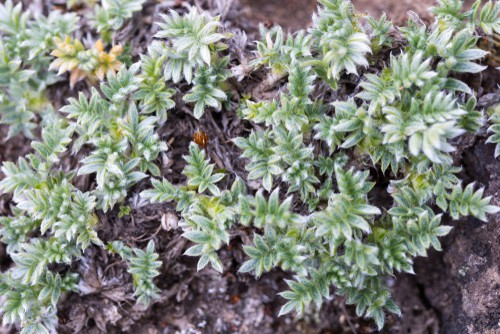Tundra plants are known for their small and stunted growth, which is primarily due to the harsh environmental conditions they face. These plants have adapted to survive in the extreme cold and windy conditions of the tundra biome, which covers about 20% of the Earth’s land surface.
The tundra biome is characterized by permafrost, a layer of frozen soil that remains frozen throughout the year, and a short growing season that lasts only a few weeks.
The soil in the tundra is also nutrient-poor, lacking in nitrogen and phosphorus, which are essential elements for plant growth. This makes it difficult for them to grow to their full potential, resulting in tundra plants small and stunted.
The growing season in the tundra is also short, and the plants have to grow quickly to produce seeds before the onset of winter. As a result, tundra plants have developed unique adaptations to survive in these challenging conditions, such as shallow root systems and the ability to photosynthesize at low temperatures.
Key Takeaways
- Tundra plants are small and stunted due to the harsh environmental conditions they face, including permafrost and nutrient-poor soil.
- These plants have adapted to survive in the extreme cold and windy conditions of the tundra biome, with unique adaptations such as shallow root systems and the ability to photosynthesize at low temperatures.
- The challenges faced by tundra plants have important implications for the larger ecosystem, including impacts on herbivores and carbon storage.
More on this category:
- What are Aerial Parts of a Plant?
- What Are the Characteristics of Plants Worksheet Answer Key?
- What are the Corn Dog Plants Called?
Understanding Tundra Plants

Defining Tundra Plants
Tundra plants are those that grow in the cold and harsh environments of the Arctic and on the tops of mountains. These plants are adapted to survive in the extreme conditions of the tundra, including low temperatures, short growing seasons, and poor soil quality.
Because of these conditions, tundra plants are typically small and stunted. They have short growing seasons of approximately 50-60 days, and the sun is low to the ground, which limits the amount of light available for photosynthesis.
Additionally, the permafrost in the tundra won’t let roots grow very deep, so plants that are shorter and need little to no soil are most efficient.
Common Tundra Plants: Mosses and Lichens
Two of the most common types of tundra plants are mosses and lichens. Mosses are small, non-vascular plants that grow in dense mats on the ground. They are able to survive in the tundra because they are able to absorb and retain water, even in the cold temperatures. Mosses also help to stabilize the soil and prevent erosion.
Lichens, on the other hand, are a symbiotic relationship between a fungus and an alga or cyanobacterium. They are able to grow in the tundra because they don’t need extensive root or water-transportation systems. Lichens are important in the tundra ecosystem because they provide food for animals like caribou and musk oxen.
Other common tundra plants include willow shrubs, which are able to grow in the tundra because they have adapted to the cold temperatures and short growing seasons. Willow shrubs are important in the tundra ecosystem because they provide habitat for animals like birds and small mammals.
Growth Conditions in Tundra
1. Low Temperature and Short Growing Season
The tundra biome is characterized by low temperatures and a short growing season, which limit the growth of plants. Tundra plants have a slow metabolic rate due to low temperatures, which results in slow growth.
The growing season is also short, lasting only a few months, which limits the amount of time that plants have to grow and reproduce. As a result, tundra plants are small and stunted, with shallow root systems and a low biomass.
2. High Latitudes and Mountains
Tundra is found in high latitudes and mountains, where the climate is too cold for trees to grow. The high latitudes and altitudes result in low temperatures, which limit the growth of plants. The mountains also create harsh growing conditions, with strong winds and thin soils that limit plant growth.
3. Snow and Winter Conditions
Snow and winter conditions also play a role in limiting plant growth in tundra. Snow cover insulates the ground, preventing plants from accessing nutrients and water. In addition, winter conditions, such as freezing temperatures and high winds, can damage plant tissues and limit growth.
4. Permafrost and Frozen Soil
Permafrost and frozen soil are also factors that limit plant growth in tundra. Permafrost is a layer of permanently frozen soil that prevents plants from accessing nutrients and water. The frozen soil also limits the depth of plant roots, which further limits plant growth.
Tundra Plant Adaptations

1. Small and Stunted Growth
Tundra plants are known for their small and stunted growth. This is due to the harsh environmental conditions in the tundra biome, which includes low temperatures, permafrost, short growing seasons, and limited nutrients. As a result, tundra plants have adapted to survive in these challenging conditions.
2. Adaptations to Low Temperatures
One of the key adaptations of tundra plants is their ability to survive in low temperatures. Tundra plants have evolved to have short, woody stems, and leaves that are small and often covered in fine hairs. This helps to protect the plant from the cold and wind, as well as reduce water loss through transpiration.
Another adaptation of tundra plants is their ability to grow close to the ground. This helps to protect the plant from the wind and cold temperatures, as well as reduce water loss through transpiration.
Additionally, the close proximity to the ground allows the plant to absorb heat from the soil, which can help to keep it warm during the cold winter months.
3. Slow Metabolic Rate
Tundra plants also have a slow metabolic rate, which helps them to conserve energy and survive in the harsh environmental conditions of the tundra biome. This slow metabolic rate means that tundra plants grow and reproduce at a slower rate than plants in other biomes.
However, this also means that tundra plants can survive for many years, even in the harshest of conditions.
4. Photosynthesis
Finally, tundra plants have adapted to the limited sunlight in the tundra biome. Tundra plants have a high chlorophyll content, which allows them to absorb as much sunlight as possible. Additionally, tundra plants have adapted to grow and flower quickly during the short summer months, when there is more sunlight available.
Challenges Faced by Tundra Plants
Tundra plants are unique in their ability to survive in one of the harshest environments on Earth. However, they face several challenges that can limit their growth and survival. This section discusses some of the most significant challenges faced by tundra plants.
1. Water and Soil Conditions
Tundra plants have to cope with limited water availability due to the short growing season and low precipitation. Drought conditions can also occur during the summer months, which can further stress the plants.
On the other hand, water-logged soil can be a problem in areas with permafrost, where the water cannot drain away. This can lead to root rot, which can kill the plant.
Soils in the tundra are often high in clay, which can make it difficult for water to penetrate the soil. This can lead to water runoff and erosion, which can expose the roots of the plants. The shallow root systems of tundra plants make them vulnerable to these conditions.
2. Nutrient Deficiency

Tundra soils are often nutrient deficient, particularly in nitrogen and phosphorus. This can limit plant growth and make them more susceptible to pests and diseases. The lack of organic matter in the soil also contributes to this problem.
Tundra plants have adapted to these conditions by developing specialized root systems that allow them to absorb nutrients efficiently.
3. Pests and Diseases
Tundra plants are also vulnerable to pests and diseases. Insects, such as aphids and caterpillars, can damage the leaves and stems of the plants. Fungal diseases, such as rust and powdery mildew, can also be a problem. Overwatering can create conditions that favor the growth of these pests and diseases.
Role of Seeds and Transplants
Importance of Seeds
Seeds are the starting point for any plant’s growth, and the tundra biome is no exception. The harsh environment of the tundra makes it difficult for plants to grow, and this is especially true for seeds.
The cold and dry conditions can cause seeds to become dormant or even die before they have a chance to germinate. Therefore, it is crucial to use high-quality seeds that are specifically adapted to the tundra environment.
In addition to using high-quality seeds, it is also important to protect them from the harsh conditions of the tundra. This can be done by planting them in a protected area, such as a cold frame or greenhouse. Row cover material can also be used to protect the seeds from the wind and cold temperatures.
Role of Transplants
Transplants are another way to grow plants in the tundra biome. Transplants are young plants that have already been started in a controlled environment, such as a greenhouse or nursery. These plants can then be transplanted into the tundra environment once they are strong enough to survive.
Transplants have several advantages over seeds. They are more likely to survive the harsh conditions of the tundra because they have already been started in a controlled environment. They are also less likely to be affected by pests and diseases because they have already been treated with pesticides and fungicides.
Impact of Tundra on Larger Ecosystem

The tundra biome is characterized by its harsh climate, low temperatures, and short growing season. The plants in this biome have adapted to these conditions, resulting in small and stunted vegetation. However, the impact of tundra extends beyond its immediate environment.
Impact on Trees and Vegetable Plants
Trees and vegetable plants are not common in the tundra biome due to the extreme conditions. The permafrost layer restricts the growth of roots, and the lack of nutrients and sunlight limits the growth of plants. As a result, the tundra biome has a limited impact on trees and vegetable plants.
Role of Fungi
Fungi play a crucial role in the tundra biome by breaking down organic matter and recycling nutrients. The cold temperatures and low precipitation in the tundra biome limit the decomposition of organic matter, making fungi essential in breaking down dead plant material.
Fungi also form mutualistic relationships with plants, providing them with nutrients and water in exchange for carbohydrates.
Despite the limited impact of tundra on trees and vegetable plants, the tundra biome has a significant impact on the larger ecosystem.
The small and stunted vegetation in the tundra biome provides habitat and food for a variety of herbivores, such as caribou, muskoxen, and arctic hares. These herbivores, in turn, provide food for predators such as wolves, foxes, and bears.
Frequently Asked Questions
What adaptations do tundra plants have to survive in harsh environments?
Tundra plants have several adaptations that help them survive in harsh environments. They have shallow roots that allow them to absorb nutrients from the top layer of soil, which is rich in organic matter.
They also have small leaves and short stems to reduce water loss through transpiration. Additionally, tundra plants have the ability to photosynthesize at low temperatures and low light levels.
How do tundra plants cope with low temperatures and short growing seasons?
Tundra plants have adapted to cope with low temperatures and short growing seasons by growing quickly during the brief summer season. They also have the ability to photosynthesize at low temperatures and low light levels.
Tundra plants also have the ability to store nutrients and energy in their roots, which allows them to survive the long, dark winter months.
What are the limiting factors that make tundra plants small and stunted?
There are several limiting factors that make tundra plants small and stunted. These include low temperatures, short growing seasons, nutrient-poor soil, and strong winds.
Additionally, the permafrost layer in the soil prevents deep root growth, which limits the ability of tundra plants to access water and nutrients.
What role do lichens and mosses play in tundra ecosystems?
Lichens and mosses play an important role in tundra ecosystems. They are the primary producers and provide a food source for herbivores such as caribou and muskoxen. Additionally, lichens and mosses help to stabilize the soil and prevent erosion.
How do tundra plants compete for resources?
Tundra plants compete for resources such as water, nutrients, and sunlight. They have adapted to grow quickly during the brief summer season to take advantage of available resources.
Additionally, tundra plants have shallow roots that allow them to absorb nutrients from the top layer of soil, which is rich in organic matter.
What are some unique characteristics of tundra plant growth?
Tundra plants have several unique characteristics of growth. They grow quickly during the brief summer season and have the ability to photosynthesize at low temperatures and low light levels.
Additionally, tundra plants have the ability to store nutrients and energy in their roots, which allows them to survive the long, dark winter months.

Hey, I’m Lisa and I’ve been an avid gardener for over 30 years. I love writing, talking and living in the garden! Feel free to connect with me on my socials below


